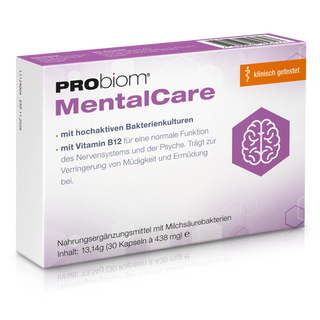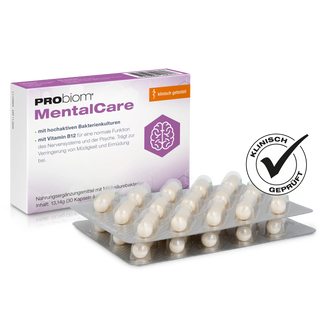Probiotics – live microorganisms with health-promoting properties – have become increasingly popular in recent years. We often think of capsules or powder, but there are actually numerous natural foods rich in probiotic cultures. Anyone looking to improve their gut health, immune system, or even skin can achieve a great deal by making a smart choice of probiotic-rich foods. In this article, you'll learn which foods contain particularly high levels of probiotics , why they're so healthy, and what to look out for when buying or preparing them.
What exactly are probiotics?
Probiotics are live bacteria or yeasts that, when consumed in sufficient quantities, have a positive effect on our health. They primarily support the balance of the intestinal flora (microbiome) and can help combat digestive problems, inflammation, or infections. Typical probiotic genera are Lactobacillus , Bifidobacterium , and Saccharomyces .
Natural probiotic foods are created through fermentation – a process in which microorganisms break down sugar or starch, producing products such as lactic acid, alcohol or carbon dioxide.
The top foods with particularly high levels of probiotics
yogurt
Yogurt is probably the best-known probiotic food. It is produced by fermenting milk with special bacterial cultures (mainly Lactobacillus bulgaricus and Streptococcus thermophilus).
-
Particularly rich in: Lactobacillus acidophilus, Bifidobacterium bifidum
-
Important: Look for varieties labeled "live cultures." Pasteurized yogurts often no longer contain live bacteria after fermentation.
kefir
Kefir is a fermented milk drink made from kefir grains. These contain a symbiotic relationship between bacteria and yeast, providing a particularly diverse probiotic composition.
-
Particularly rich in: Lactobacillus kefiranofaciens, Lactobacillus kefiri, Saccharomyces kefir
-
Fun fact: Kefir often contains up to 30 different probiotic strains – significantly more than yogurt!
sauerkraut
Sauerkraut is made from finely chopped white cabbage fermented using lactic acid fermentation. It's not only an excellent source of probiotics but also rich in vitamin C, fiber, and antioxidants.
-
Particularly rich in: Lactobacillus plantarum, Lactobacillus brevis
-
Important: Only raw, unpasteurized sauerkraut contains live cultures. Pasteurized sauerkraut from supermarket shelves is often "dead."
Kimchi
Kimchi is the Korean version of fermented cabbage and is usually seasoned with chili, ginger, garlic, and spring onions. The fermentation process produces diverse probiotic strains.
-
Particularly rich in: Lactobacillus kimchii, Lactobacillus sakei
-
Health tip: The spiciness of kimchi can also have an anti-inflammatory effect.
Miso
Miso is a Japanese seasoning paste made from fermented soybeans, barley, or rice. It is traditionally used to make miso soup.
-
Particularly rich in: Lactobacillus acidophilus, Aspergillus oryzae (a beneficial fungus)
-
Important: Miso should not be heated too much to preserve the live cultures (e.g. only heat soup, do not boil it).
Tempeh
Tempeh originates from Indonesia and is produced by fermenting soybeans with the fungus Rhizopus oligosporus .
-
Particularly rich in: beneficial mold fungi and secondary bacteria
-
Bonus: Tempeh is also a fantastic source of plant-based protein.
Kombucha
Kombucha is a fermented tea drink that is produced using a so-called SCOBY (“Symbiotic Culture Of Bacteria and Yeast”).
-
Particularly rich in: various Lactobacillus species, Gluconacetobacter xylinus
-
Note: Kombucha also contains small amounts of alcohol and should be consumed with caution by sensitive individuals.
Natto
Natto is another fermented soy product from Japan. It has a very distinctive, intense flavor and a sticky texture—not everyone's cup of tea, but extremely healthy!
-
Particularly rich in: Bacillus subtilis
-
Advantage: In addition to probiotics, natto contains the enzyme nattokinase, which can have a blood pressure-lowering effect.
Tips for consuming as many probiotics as possible
-
Look for raw, unpasteurized versions: Pasteurization kills living microorganisms.
-
Build in diversity: Different foods provide different strains and types of bacteria – the more diverse, the better for the microbiome.
-
Regularity counts: Small amounts daily are better than occasional large portions.
-
Ferment yourself: Homemade products often contain more and more diverse probiotics than industrial products.
Conclusion
Foods like kefir, raw sauerkraut, kimchi, yogurt, kombucha, miso, tempeh , and natto are true treasure troves of natural probiotics. Regularly incorporating such fermented products into your diet not only supports your gut flora, but also your immune system, skin health, and overall well-being.
Whether you start gently with yogurt or bravely try natto – your microbiome will thank you!


















